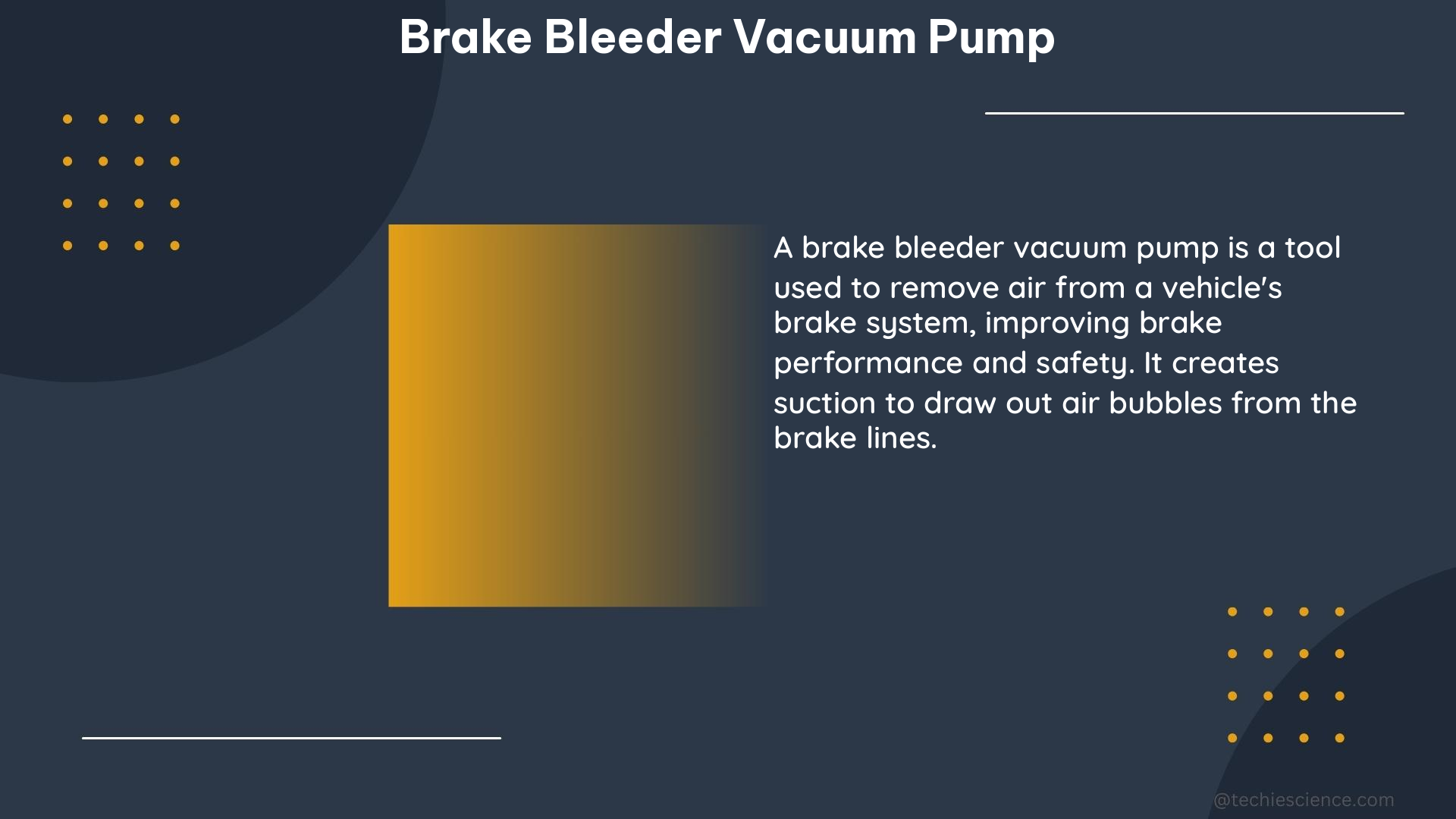A brake bleeder vacuum pump is an essential tool for maintaining the safety and performance of a car’s braking system. This device creates a vacuum that draws brake fluid through the brake lines, effectively removing any air bubbles that may have accumulated. Whether you’re a seasoned mechanic or a DIY enthusiast, understanding the technical specifications and proper usage of a brake bleeder vacuum pump can make all the difference in ensuring your vehicle’s brakes are in top condition.
Understanding the Key Specifications
When it comes to selecting the right brake bleeder vacuum pump, there are several key specifications to consider:
Vacuum Pressure
The vacuum pressure of a brake bleeder vacuum pump is typically measured in inches of mercury (inHg). A good quality pump should be able to generate a vacuum of at least 20 inHg, which is the minimum recommended pressure for effectively bleeding brake systems. However, for optimal performance, a vacuum pump with a pressure range of 25-30 inHg is ideal.
Flow Rate
The flow rate of a brake bleeder vacuum pump refers to the volume of brake fluid that the pump can move through the brake lines per minute. A higher flow rate means a faster and more efficient bleeding process. For example, the Mityvac MV8000 Brake Bleeder Vacuum Pump has a flow rate of 1.3 quarts per minute, which is considered a high-performance specification.
Size and Weight
The size and weight of the brake bleeder vacuum pump are also important factors to consider, especially for DIY users. A larger, heavier pump may be more difficult to maneuver and store, while a smaller, more compact pump may be easier to handle but may not have as much power. When choosing a pump, consider the available workspace in your garage or workshop and the ease of transportation.
Proper Usage and Technique

Using a brake bleeder vacuum pump correctly is crucial to ensure the complete removal of air from the brake system. Here’s a step-by-step guide on the proper usage technique:
-
Prepare the Brake System: Start by locating the bleeder valves on each wheel’s brake caliper or wheel cylinder. Ensure that the brake fluid reservoir is filled to the appropriate level.
-
Connect the Vacuum Pump: Attach the vacuum pump’s hose to the bleeder valve, making sure the connection is secure. Place the other end of the hose in a clear container to collect the used brake fluid.
-
Create the Vacuum: Turn on the vacuum pump and allow it to create a strong vacuum, typically around 20-25 inHg. This will draw the brake fluid through the lines and force out any air bubbles.
-
Open the Bleeder Valve: While the vacuum pump is running, slowly open the bleeder valve. This will allow the brake fluid to flow through the lines and into the collection container.
-
Monitor the Fluid Flow: Observe the flow of the brake fluid and listen for the sound of air bubbles being expelled. Continue this process until the fluid flowing out of the bleeder valve is free of air bubbles.
-
Repeat the Process: Move to the next bleeder valve and repeat the process until all wheels have been bled. Be sure to top up the brake fluid reservoir as needed.
-
Finalize the Procedure: Once all the bleeder valves have been bled, close them securely and disconnect the vacuum pump. Ensure that the brake fluid reservoir is filled to the appropriate level.
It’s important to note that the specific bleeding procedure may vary depending on the make and model of your vehicle. Always refer to the manufacturer’s instructions or consult a professional mechanic if you’re unsure about the proper technique.
Troubleshooting and Maintenance
While a brake bleeder vacuum pump is a reliable tool, it’s essential to maintain it properly to ensure its longevity and optimal performance. Here are some troubleshooting tips and maintenance recommendations:
Troubleshooting
- If the vacuum pump is not generating enough suction, check for any air leaks in the hose connections or the pump itself.
- If the brake fluid appears discolored or contaminated, it may be time to flush the entire brake system.
- If the pump is not turning on or is making unusual noises, it may be a sign of a mechanical issue that requires professional repair.
Maintenance
- Clean the vacuum pump and its components after each use to prevent the buildup of brake fluid and debris.
- Regularly check the condition of the hoses and replace them if they show signs of wear or damage.
- Store the vacuum pump in a dry, clean environment to protect it from environmental factors.
- Refer to the manufacturer’s recommendations for any specific maintenance or service requirements.
By understanding the technical specifications, proper usage, and maintenance of a brake bleeder vacuum pump, DIY enthusiasts can confidently tackle brake system maintenance and ensure the safety and performance of their vehicles.
References:
- Brake Bleeding with a Vacuum Pump – YouTube
- Do vacuum pumps for bleeding brakes work? – Reddit
- Mityvac MV8000 Brake Bleeder Vacuum Pump Specifications
- Vacuum Brake Bleeder Tip – Bob Is The Oil Guy
- Wilmar Corporation Performance Tool Brake Bleeder Vacuum Pump Instructions

The lambdageeks.com Core SME Team is a group of experienced subject matter experts from diverse scientific and technical fields including Physics, Chemistry, Technology,Electronics & Electrical Engineering, Automotive, Mechanical Engineering. Our team collaborates to create high-quality, well-researched articles on a wide range of science and technology topics for the lambdageeks.com website.
All Our Senior SME are having more than 7 Years of experience in the respective fields . They are either Working Industry Professionals or assocaited With different Universities. Refer Our Authors Page to get to know About our Core SMEs.